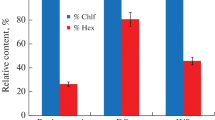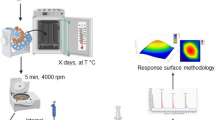Abstract
Petroleum ether was used to extract petroleum hydrocarbons from soils collected from six oil fields with different history of exploratory and contamination. It was capable of fast removing 76–94 % of the total petroleum hydrocarbons including 25 alkanes (C11–C35) and 16 US EPA priority polycyclic aromatic hydrocarbons from soils at room temperature. The partial least squares analysis indicated that the solvent extraction efficiencies were positively correlated with soil organic matter, cation exchange capacity, moisture, pH, and sand content of soils, while negative effects were observed in the properties reflecting the molecular size (e.g., molecular weight and number of carbon atoms) and hydrophobicity (e.g., water solubility, octanol–water partition coefficient, soil organic carbon partition coefficient) of hydrocarbons. The high concentration of weathered crude oil at the order of 105 mg kg−1 in this study was demonstrated adverse for solvent extraction by providing an obvious nonaqueous phase liquid phase for hydrocarbon sinking and increasing the sequestration of soluble hydrocarbons in the insoluble oil fractions during weathering. A full picture of the mass distribution and transport mechanism of petroleum contaminants in soils will ultimately require a variety of studies to gain insights into the dynamic interactions between environmental indicator hydrocarbons and their host oil matrix.




Similar content being viewed by others
References
Ahn CK, Kim YM, Woo SH, Park JM (2008) Soil washing using various nonionic surfactants and their recovery by selective adsorption with activated carbon. J Hazard Mater 154:153–160
Alexander M (1995) How toxic are toxic chemicals in soil? Environ Sci Technol 29:2713–2717
Alexander M (2000) Aging, bioavailability, and overestimation of risk from environmental pollutants. Environ Sci Technol 34:4259–4265
Avila-Chavez MA, Trejo A (2010) Remediation of soils contaminated with total petroleum hydrocarbons and polycyclic aromatic hydrocarbons: extraction with supercritical ethane. Ind Eng Chem Res 49:3342–3348
Bauder T, Barbarick K, Ippolito J, Shanahan J, Ayers P (2005) Soil properties affecting wheat yields following drilling-fluid application. J Environ Qual 34:1687–1696
Boyd SA, Sun S (1990) Residual petroleum and polychlorobiphenyl oils as sorptive phases for organic contaminants in soils. Environ Sci Technol 24:142–144
Brassington KJ, Hough RL, Paton GI, Semple KT, Risdon GC, Crossley J, Hay I, Askari K, Pollard SJT (2007) Weathered hydrocarbon wastes: a risk management primer. Crit Rev Environ Sci Technol 37:199–232
Brassington K, Pollard S, Coulon F (2010) Handbook of hydrocarbon and lipid microbiology, Weathered hydrocarbon biotransformation: implications for bioremediation, analysis, and risk assessment. Springer, Heidelberg, pp 2487–2499
Brohon B, Delolme C, Gourdon R (2001) Complementarity of bioassays and microbial activity measurements for the evaluation of hydrocarbon-contaminated soils quality. Soil Biol Biochem 33:883–891
Coulon F, Whelan MJ, Paton GI, Semple KT, Villa R, Pollard SJT (2010) Multimedia fate of petroleum hydrocarbons in the soil: oil matrix of constructed biopiles. Chemosphere 81:1454–1462
Feng X, Simpson AJ, Simpson MJ (2006) Investigating the role of mineral-bound humic acid in phenanthrene sorption. Environ Sci Technol 40:3260–3266
Flores-Céspedes F, Fernández-Pérez M, Villafranca-Sánchez M, González-Pradas E (2006) Cosorption study of organic pollutants and dissolved organic matter in a soil. Environ Pollut 142:449–456
Freeman HM, Harris EF (1995) Hazardous waste remediation: innovative treatment technologies. CRC, Boca Raton
Gong Z, Wilke BM, Alef K, Li P (2005) Influence of soil moisture on sunflower oil extraction of polycyclic aromatic hydrocarbons from a manufactured gas plant soil. Sci Total Environ 343:51–59
Han M, Ji GD, Ni JR (2009) Washing of field weathered crude oil contaminated soil with an environmentally compatible surfactant, alkyl polyglucoside. Chemosphere 76:579–586
He L, Li X, Wu G, Lin F, Sui H (2013) Distribution of saturates, aromatics, resins and asphaltenes fractions in the bituminous layer of Athabasca oil sands. Energ Fuel 27:4677–4683
ISO (2010) BS ISO 11277:2009: Determination of particle size distribution in mineral soil material—method by sieving and sedimentation
Ji G, Zhou G (2007) Remediation of soil contaminated with oil pollutants by ex-situ chemical washing. Acta Sci Nat—Univ Pekin (Chin) 43:863–871
Jonsson S, Persson Y, Frankki S, van Bavel B, Lundstedt S, Haglund P, Tysklind M (2007) Degradation of polycyclic aromatic hydrocarbons (PAHs) in contaminated soils by Fenton’s reagent: a multivariate evaluation of the importance of soil characteristics and PAH properties. J Hazard Mater 149:86–96
Jonsson S, Lind H, Lundstedt S, Haglund P, Tysklind M (2010) Dioxin removal from contaminated soils by ethanol washing. J Hazard Mater 179:393–399
Khodadoust AP, Reddy KR, Maturi K (2005) Effect of different extraction agents on metal and organic contaminant removal from a field soil. J Hazard Mater 117:15–24
Latawiec AE, Reid BJ (2010) Sequential extraction of polycyclic aromatic hydrocarbons using subcritical water. Chemosphere 78:1042–1048
Lau EV, Gan S, Ng HK, Poh PE (2014) Extraction agents for the removal of polycyclic aromatic hydrocarbons (PAHs) from soil in soil washing technologies. Environ Pollut 184:640–649
Li X, Du Y, Wu G, Li Z, Li H, Sui H (2012a) Solvent extraction for heavy crude oil removal from contaminated soils. Chemosphere 88:245–249
Li X, He L, Wu G, Sun W, Li H, Sui H (2012b) Operational parameters, evaluation methods, and fundamental mechanisms: aspects of nonaqueous extraction of bitumen from oil sands. Energ Fuel 26:3553–3563
Lian J, Shi S, Guo M, Li X (2009) Influence of soil properties on the solvent extraction of oil from contaminated soil using n-hexane. Chem Ind Eng Process (Chin) 28:530–532
Mackay D (2001) Multimedia environmental models: the fugacity approach. Lewis, Chelsea
Mackay D, Shiu WY, Ma KC (1997) Illustrated handbook of physical-chemical properties and environmental fate for organic chemicals: pesticide chemicals, 5. CRC, Boca Raton
Masakorala K, Yao J, Chandankere R, Liu H, Liu W, Cai M, Choi MM (2013) A combined approach of physicochemical and biological methods for the characterization of petroleum hydrocarbon-contaminated soil. Environ Sci Pollut Res. doi:10.1007/s11356-013-1923-3
Montoneri E, Boffa V, Savarino P, Tambone F, Adani F, Micheletti L, Gianotti C, Chiono R (2009) Use of biosurfactants from urban wastes compost in textile dyeing and soil remediation. Waste Manage 29:383–389
Navarro-Villoslada F, Vicente BS, Moreno-Bondi MC (2004) Application of multivariate analysis to the screening of molecularly imprinted polymers for bisphenol A. Anal Chim Acta 504:149–162
Nelson S, Farmer W, Letey J, Williams C (2000) Stability and mobility of napropamide complexed with dissolved organic matter in soil columns. J Environ Qual 29:1856–1862
Niederer C, Schwarzenbach RP, Goss K-U (2007) Elucidating differences in the sorption properties of 10 humic and fulvic acids for polar and nonpolar organic chemicals. Environ Sci Technol 41:6711–6717
Painter P, Williams P, Lupinsky A (2010) Recovery of bitumen from Utah tar sands using ionic liquids. Energ Fuel 24:5081–5088
Pelley AJ, Tufenkji N (2008) Effect of particle size and natural organic matter on the migration of nano- and microscale latex particles in saturated porous media. J Colloid Interface Sci 321:74–83
Pignatello JJ, Xing B (1996) Mechanisms of slow sorption of organic chemicals to natural particles. Environ Sci Technol 30:1–11
Pollard SJT, Hough RL, Kim KH, Bellarby J, Paton G, Semple KT, Coulon F (2008) Fugacity modelling to predict the distribution of organic contaminants in the soil: oil matrix of constructed biopiles. Chemosphere 71:1432–1439
Quagliotto P, Montoneri E, Tambone F, Adani F, Gobetto R, Viscardi G (2006) Chemicals from wastes: compost-derived humic acid-like matter as surfactant. Environ Sci Technol 40:1686–1692
Reid BJ, Jones KC, Semple KT (2000) Bioavailability of persistent organic pollutants in soils and sediments—a perspective on mechanisms, consequences and assessment. Environ Pollut 108:103–112
Risdon GC, Pollard SJT, Brassington KJ, McEwan JN, Paton GI, Semple KT, Coulon F (2008) Development of an analytical procedure for weathered hydrocarbon contaminated soils within a UK risk-based framework. Anal Chem 80:7090–7096
Saterbak A, Toy RJ, Wong DC, McMain BJ, Williams MP, Dorn PB, Brzuzy LP, Chai EY, Salanitro JP (1999) Ecotoxicological and analytical assessment of hydrocarbon‐contaminated soils and application to ecological risk assessment. Environ Toxicol Chem 18:1591–1607
Semple KT, Reid BJ, Fermor TR (2001) Impact of composting strategies on the treatment of soils contaminated with organic pollutants. Environ Pollut 112:269–283
Shu YY, Lai TL (2001) Effect of moisture on the extraction efficiency of polycyclic aromatic hydrocarbons from soils under atmospheric pressure by focused microwave-assisted extraction. J Chromatogr A 927:131–141
Silva A, Delerue-Matos C, Fiuza A (2005) Use of solvent extraction to remediate soils contaminated with hydrocarbons. J Hazard Mater 124:224–229
Sun S, Boyd SA (1991) Sorption of polychlorobiphenyl (PCB) congeners by residual PCB-oil phases in soils. J Environ Qual 20:557–561
Sun K, Jin J, Kang M, Zhang Z, Pan Z, Wang Z, Wu F, Xing B (2013) Isolation and characterization of different organic matter fractions from a same soil source and their phenanthrene sorption. Environ Sci Technol 47:5138–5145
Thibaud C, Erkey C, Akgerman A (1993) Investigation of the effect of moisture on the sorption and desorption of chlorobenzene and toluene from soil. Environ Sci Technol 27:2373–2380
TPHCWG (1999) Total Petroleum Hydrocarbon Criteria Working Group Series Volume 5: Human health risk-based evaluation of petroleum release sites: implementing the working group approach. Amherst Scientific, Amherst
Valsecchi G, Gigliotti C, Farini A (1995) Microbial biomass, activity, and organic matter accumulation in soils contaminated with heavy metals. Biol Fertil Soils 20:253–259
Viglianti C, Hanna K, De Brauer C, Germain P (2006) Removal of polycyclic aromatic hydrocarbons from aged-contaminated soil using cyclodextrins: experimental study. Environ Pollut 140:427–435
Vinzi VE (2010) Handbook of partial least squares: concepts, methods and applications. Springer, Heidelberg
Wehrer M, Totsche KU (2009) Difference in PAH release processes from tar-oil contaminated soil materials with similar contamination history. Chem Erde-Geochem 69:109–124
Wen B, Zhang J, Zhang S, Shan X, Khan SU, Xing B (2007) Phenanthrene sorption to soil humic acid and different humin fractions. Environ Sci Technol 41:3165–3171
Wu G (2012) Insights into sustainable environmental remediation approaches and the fate and transport of petroleum hydrocarbons in soils. Dissertation, Tianjin University
Wu G, Li X, Coulon F, Li H, Lian J, Sui H (2011) Recycling of solvent used in a solvent extraction of petroleum hydrocarbons contaminated soil. J Hazard Mater 186:533–539
Wu G, Coulon F, Yang Y, Li H, Sui H (2013a) Combining solvent extraction and bioremediation for removing weathered petroleum from contaminated soil. Pedosphere 23:455–463
Wu G, He L, Chen D (2013b) Sorption and distribution of asphaltene, resin, aromatic and saturate fractions of heavy crude oil on quartz surface: molecular dynamic simulation. Chemosphere 92:1465–1471
Wu G, Kechavarzi C, Li X, Sui H, Pollard SJT, Coulon F (2013c) Influence of mature compost amendment on total and bioavailable polycyclic aromatic hydrocarbons in contaminated soils. Chemosphere 90:2240–2246
Yang Y, Tao S, Zhang N, Zhang DY, Li XQ (2010a) The effect of soil organic matter on fate of polycyclic aromatic hydrocarbons in soil: a microcosm study. Environ Pollut 158:1768–1774
Yang Y, Zhang N, Xue M, Tao S (2010b) Impact of soil organic matter on the distribution of polycyclic aromatic hydrocarbons (PAHs) in soils. Environ Pollut 158:2170–2174
Zemanek MG, Pollard SJT, Kenefick SL, Hrudey SE (1997) Multi-phase partitioning and co-solvent effects for polynuclear aromatic hydrocarbons (PAH) in authentic petroleum- and creosote-contaminated soils. Environ Pollut 98:239–252
Acknowledgments
This work was financially supported by National Natural Science Foundation of China (No. 21307069, No. 21306129 and No. 41201497), Municipal Natural Science Foundation of Tianjin (No. 12JCQNJC05300), Guangdong Natural Science Foundation (No. S2013040012413), and China Postdoctoral Science Foundation (No. 2013M530641).
Author information
Authors and Affiliations
Corresponding author
Additional information
Responsible editor: Ester Heath
Electronic supplementary material
Below is the link to the electronic supplementary material.
ESM 1
(DOC 149 kb)
Rights and permissions
About this article
Cite this article
Sui, H., Hua, Z., Li, X. et al. Influence of soil and hydrocarbon properties on the solvent extraction of high-concentration weathered petroleum from contaminated soils. Environ Sci Pollut Res 21, 5774–5784 (2014). https://doi.org/10.1007/s11356-014-2511-x
Received:
Accepted:
Published:
Issue Date:
DOI: https://doi.org/10.1007/s11356-014-2511-x




